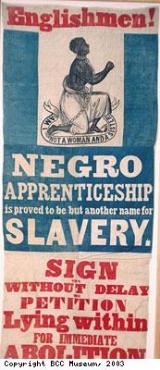Apprenticeship: slavery by another name?
Slavery had existed for about 200 years in British colonies, such as the island of Jamaica in the Caribbean. The system of slavery was ended in 1838. The campaign which played a part in bringing this about was called ‘Abolition’. Abolition meant that the actual buying and selling of slaves was made illegal. The next stage was for the emancipation of the slaves, to make them free. Slave owners fought hard against the emancipation of their slaves. When the Emancipation Act was finally passed in 1833, it did not automatically give the slaves their freedom. This was because it was felt that the slaves were not used to being independent. Instead it was thought that they needed help and training to be free men and women. Slaves therefore became ‘apprentices’ and continued to work for low wages under their old masters. Supposedly, they were being trained to be free. Because of the way that this system worked, the end of slavery did not really mean freedom for the slaves. Apprenticeship was seen by many as another form of slavery. True freedom came in 1838, when the apprenticeship system was abolished. But even then, many of the freed slaves had no option but to continue working for their old masters for low wages.
Several medallions were issued to mark the Emancipation Act of 1834. They all show freed slaves celebrating their new freedom. In fact, the Emancipation Act (or law) of 1834 did not come into effect immediately. The slaves were made apprentices, which many abolitionists considered was simply slavery under a different name.




